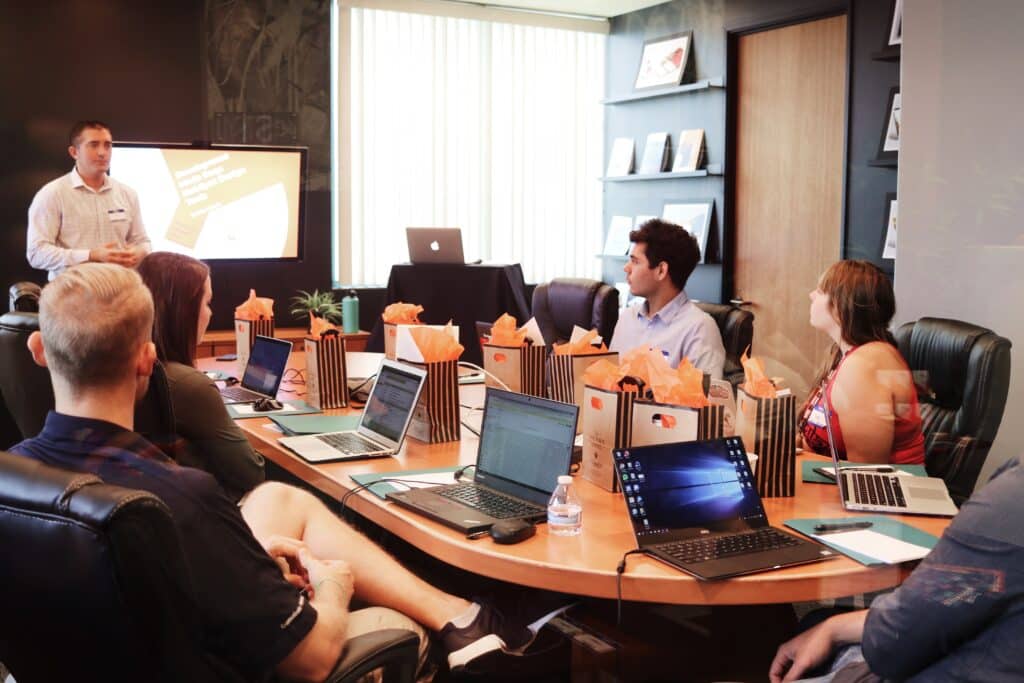“Redefining Employers Approach with New Employee Onboarding and Adaptation Plan” is a detailed guide that provides employers a dynamic yet comprehensive new hire onboarding checklist. It walks you through every step, from the beginnings of job requisition documents to the closure of live job postings. It details the range of paperwork your new hire needs, like contracts and tax documents, to onboarding essentials like preparing workspaces and equipment in advance. You will learn how to foster an inclusive atmosphere with new employee announcements, orientation, and a welcome package that includes email communication before the job commencement. It emphasizes the importance of a supportive mentor and building tours, if applicable, and brilliant tactics like the 30-, 60-, and 90-day check-ins to track your new hire’s adjustment to the role. This includes scheduling time for onboarding feedback, with continual updates and revisions to the onboarding checklist to cater to changing needs and boost efficiency.

Understanding the Importance of a Comprehensive Onboarding and Adaptation Plan
Why a thorough onboarding process is necessary
You might ask, why go through the trouble of setting up an elaborate onboarding process? Well, the answer is simple. A thorough onboarding process is necessary because it provides new hires with the initial support they need to understand the company culture, processes, and overall expectations. This is not just any ordinary step but a pivotal stage in an employee’s lifecycle, as it helps in setting a clear path for success in their new role.
The impact of a successful adaptation plan on retention rates
Interestingly, the completion of a successful adaptation plan hugely impacts employee retention rates. When new hires are properly onboarded, they feel more connected and engaged with their work. This connection and engagement can translate into longer tenures and lower turnover rates, preserving the company’s resources and culture in the long run.
The cost implications of ineffective onboarding processes
As with anything, there’s a cost tied to ineffective onboarding processes. A lack of in-depth and successful onboarding can result in confusion, dissatisfaction, and ultimately, high turnover rates. This not only directly impacts a company’s bottom line due to increased hiring costs but it may also affect team morale and productivity.
The Modern New Hire Onboarding Checklist
Job requisition and closing out job postings
Once you’ve found the right person for the job, it’s important to ensure all logistical aspects are taken care of. Submit a job requisition document to the relevant team for approval before closing out live job postings. This helps streamline your recruiting process and keep your data accurate.
Preparation of new hire paperwork
A new job means new paperwork. This includes tax documents, contracts, payroll information, and other necessary forms. Your team must prepare all these materials in advance to ensure a smooth onboarding transition for the new hire.
Device and equipment advance setup
Remember to save your new hire from technical glitches by setting up all necessary devices and equipment ahead of time. This includes any computers, phones, software accounts and login credentials they will need for their role.
Setting up workspaces and welcome kits
To feel truly welcomed, it’s beneficial if a new hire’s workspace is organized and prepared ahead of time. If applicable, preparing a welcome kit can add a personal touch that helps them feel part of the team right away.
Creating a Welcoming First Day Experience
Scheduling new hire orientation
A well-planned orientation will ensure that new hires get familiar with the company culture and organisational structure. Block out schedules and create an itinerary for their first day, providing them with a positive and informative experience.
Sending out welcome emails
What better way to make a new hire feel welcomed even before they start than a warm and engaging welcome email? Be sure to include any necessary details they should know about their first day, along with any encouraging words or company mottos.
Conducting a building tour
In case your business has a physical location, conducting a building tour is a good way to familiarize the new employee with their workplace. Showing them the important places such as restrooms, kitchens, or emergency exits allows for a much smoother transition.
Assigning Peer Mentor for New Hires
Role and benefits of a peer mentor
Having a peer mentor can often ease the onboarding process for new hires, making them feel more comfortable and well-guided. Mentors enlighten new hires about the nitty-gritty of day-to-day operations and give them someone to turn to with any immediate questions or uncertainties.
How to choose the right peer mentor
Choosing the right peer mentor is equally important. Mentors should be individuals who exemplify your company’s culture, reflect its values and have a deep understanding of their role and responsibilities. They should also have good communication skills and be patient and understanding.

Communicating with Existing Team Members
Incorporating new hire announcements
It’s critical to communicate the arrival of new employees to your existing team members. Anannouncement or a brief introduction can foster transparency and encourage team members to extend a warm welcome to their new colleagues.
Scheduling welcoming lunches for team bonding
A welcome lunch can serve as an informal platform for interaction, helping new hires feel instantly part of the team. It also offers an opportunity for existing members to know a little about them, and for new hires to learn more about the team and company culture.
Implementing Onboarding Feedback Sessions
Importance of onboarding feedback
Onboarding feedback sessions can be a gamechanger. Such sessions provide valuable insights into the effectiveness of your onboarding processes, the experiences of new hires, and areas where you can improve.
When and how to schedule feedback sessions
A good time to schedule onboarding feedback sessions is typically a week or two after the new hire has started. Include this in your initial schedule to ensure you get timely feedback when the experience is still fresh in their mind.

Scheduling Regular Check-ins
Introducing a 30, 60, and 90-day check-in plan
Keep the lines of communication open with regular check-ins at the 30, 60, and 90-day marks of the new hire’s journey. It’s an effective strategy to watch their adaptation and progress and to address any issues that may arise in a timely manner.
What to include in each check-in
Each check-in should assess the progress of the new hire and revisit their goals, expectations, and any challenges they may be facing. This prompts an open discussion that makes the new hire feel valued and heard.
Using check-ins to measure new hire adaptation
The check-ins are also an excellent tool to monitor the adaptation of the new hires. You can measure their understanding of their role, the company culture and how comfortable they are in their new environment.
Constantly Updating and Revising the Onboarding Checklist
Maintaining flexibility in onboarding and adaptation processes
Keeping your onboarding and adaptation process flexible is crucial to meet both company’s and new hires’ changing needs. Use feedback from new hires to adjust and modify your processes to work towards a more favourable onboarding experience.
Using feedback to inform checklist revisions
Take each piece of feedback to heart – positive or negative. This information is incredibly valuable and should be used to revise your onboarding checklist and inform any changes you make to the process.
Incorporating Company Culture into the Onboarding Process
Why company culture forms an integral part of onboarding
Company culture is more than just a mere statement or slogan. It forms the very essence of your organization’s identity. Incorporating this into your onboarding process gives the new hire a clear view of what your company represents and what values it upholds.
Ways to infuse company culture into the process
Be creative with how you introduce your company culture. It could be through stories, values workshops, culture ambassadors, or simply the way you communicate and interact. Keep it authentic and consistent to give new hires a true taste of your culture.
Looking at the Future of Employee Onboarding and Adaptation
Upcoming trends in onboarding
the future of onboarding holds interesting prospects. Be it virtual reality onboarding, the usage of AI in training programs, or increased emphasis on soft-skills training, it’s important to keep a close eye on upcoming trends to keep your onboarding process fresh and relevant.
How to stay proactive in improving onboarding processes
Improving your onboarding process is a never-ending task. Always be on the lookout for methods to enhance your process. Routinely collect and analyze feedback, participate in industry talks, and learn from other companies. Stay adaptable to the changing needs of employees and strive to create the best welcoming experience for new hires.
